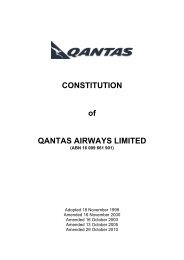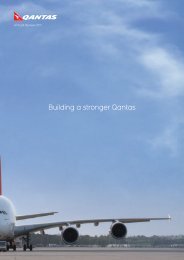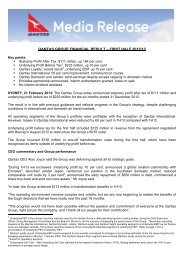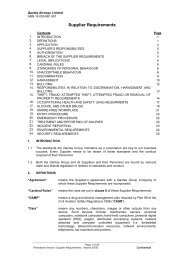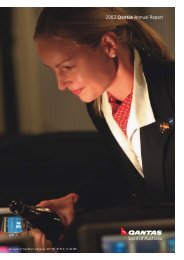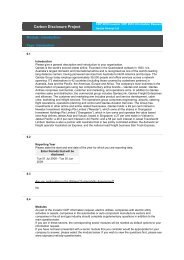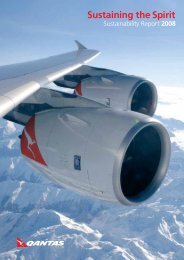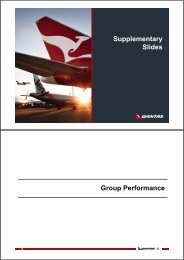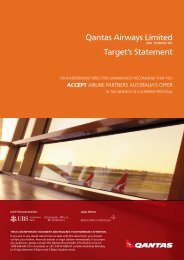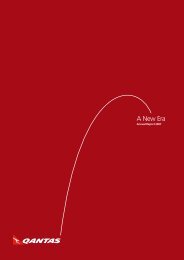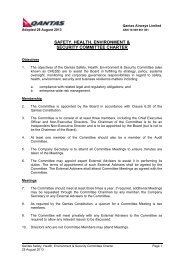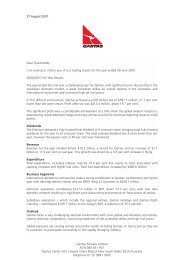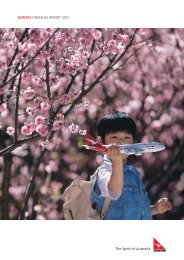2002 Qantas Annual Report
2002 Qantas Annual Report
2002 Qantas Annual Report
Create successful ePaper yourself
Turn your PDF publications into a flip-book with our unique Google optimized e-Paper software.
discussion and analysis of the statement of financial performance continued<br />
for the year ended 30 June <strong>2002</strong><br />
Review of expenditure<br />
• Total expenditure increased by 12.1 per cent on capacity growth of 3.2 per cent and a higher proportion of more<br />
expensive domestic flying.<br />
– higher manpower and staff-related expenditure, of 5.5 per cent was due to the increase in full-time employees as a<br />
result of greater activity and the provision of an incentive bonus to all staff, partially offset by efficiency gains;<br />
– aircraft operating variable expenditure, which includes maintenance material costs, crew expenses, route navigation<br />
and landing fees, increased by 8.8 per cent, primarily due to additional activity, the ageing of the aircraft fleet and the<br />
adverse impact of foreign exchange rate movements;<br />
– increases in fuel and oil expenditure, of 18.1 per cent were a direct result of additional flying, the weaker<br />
Australian dollar relative to the US dollar and a reduction in fuel hedging benefits partially offset by the lower average<br />
price of jet fuel;<br />
– computer and communication costs increased by 11.9 per cent as a result of additional reservation fees driven by<br />
increased passenger numbers;<br />
– increased non-cancellable operating lease rentals of 40.6 per cent were mainly due to leasing of additional aircraft; and<br />
– increased capacity hire of 127.0 per cent was due to short-term leases entered into to cover capacity requirements<br />
following the collapse of Ansett.<br />
Review of other statement of financial performance items<br />
• Net borrowing costs decreased by 51.1 per cent. Although average net debt was higher than the prior year, $77.0 million<br />
of interest was capitalised into aircraft progress payments and other infrastructure projects.<br />
• Income tax expense relating to ordinary activities increased by 13.7 per cent in line with increased profitability. The<br />
effective tax rate increased by 2.3 percentage points to 32.0 per cent due to the impact of an individually significant tax<br />
benefit recognised in the prior year partially offset by the favourable movement as a result of a reduction in the corporate<br />
tax rate to 30 per cent in the current financial year.<br />
Impact of exchange rates on the statement of financial performance<br />
The <strong>Qantas</strong> Group is exposed to foreign exchange rate fluctuations on the Australian dollar value of foreign currency<br />
dominated revenue and expenditure. The <strong>Qantas</strong> Group earns revenue in approximately 80 different countries, reflecting<br />
its route structure and location of ticket sales. The <strong>Qantas</strong> Group’s foreign currency costs are primarily denominated in United<br />
States dollars and relate largely to fuel, engineering and maintenance materials, and lease rentals.<br />
The <strong>Qantas</strong> Group manages its foreign currency exposures by using a variety of long-term and short-term financial<br />
instruments, in accordance with its risk management policies. The overall economic impact of exchange rate movements<br />
on the profit result in comparison to last year was $51.0 million adverse.<br />
p<br />
36<br />
THE SPIRIT OF AUSTRALIA



